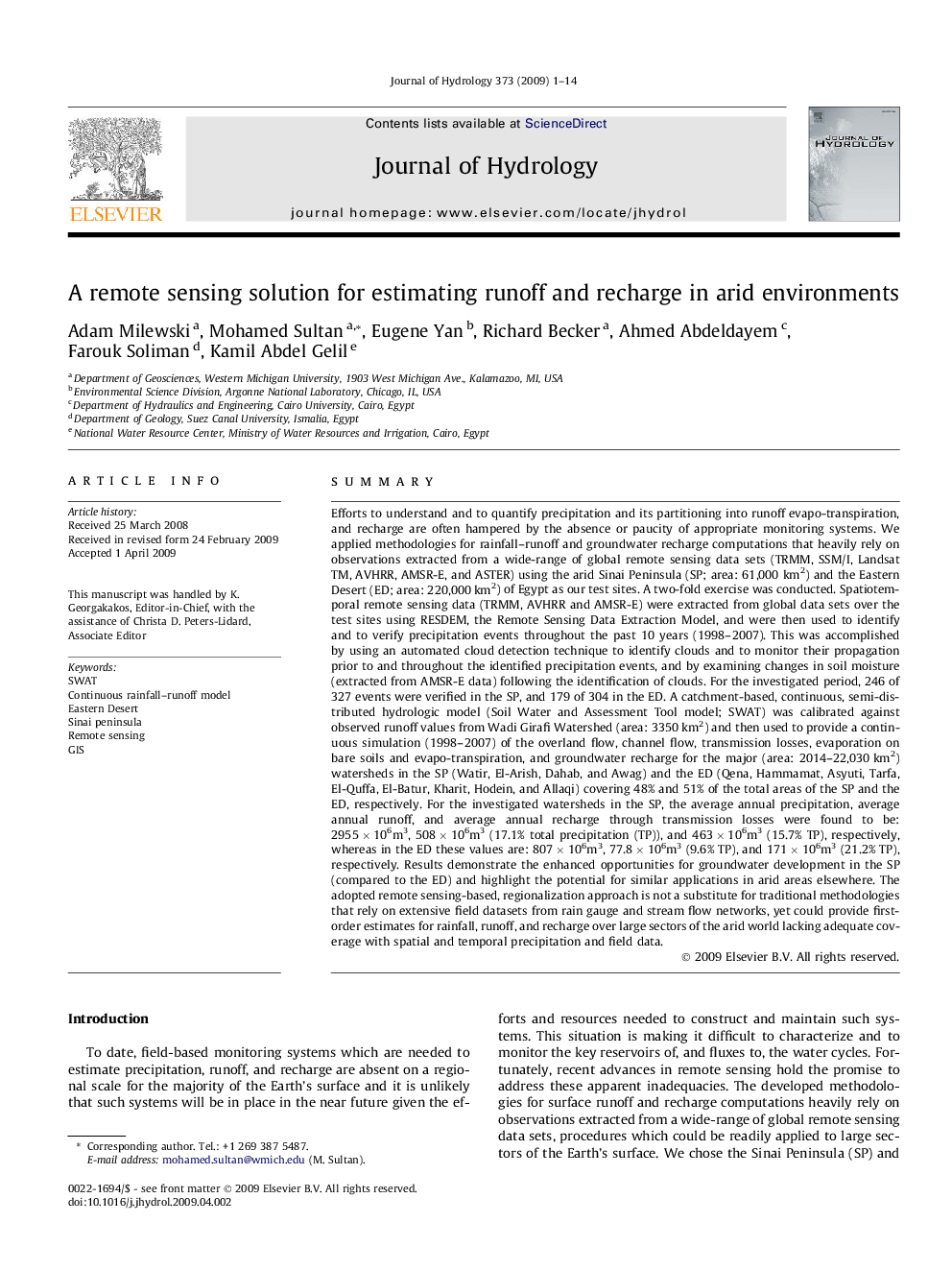| کد مقاله | کد نشریه | سال انتشار | مقاله انگلیسی | نسخه تمام متن |
|---|---|---|---|---|
| 4578851 | 1630079 | 2009 | 14 صفحه PDF | دانلود رایگان |

SummaryEfforts to understand and to quantify precipitation and its partitioning into runoff evapo-transpiration, and recharge are often hampered by the absence or paucity of appropriate monitoring systems. We applied methodologies for rainfall–runoff and groundwater recharge computations that heavily rely on observations extracted from a wide-range of global remote sensing data sets (TRMM, SSM/I, Landsat TM, AVHRR, AMSR-E, and ASTER) using the arid Sinai Peninsula (SP; area: 61,000 km2) and the Eastern Desert (ED; area: 220,000 km2) of Egypt as our test sites. A two-fold exercise was conducted. Spatiotemporal remote sensing data (TRMM, AVHRR and AMSR-E) were extracted from global data sets over the test sites using RESDEM, the Remote Sensing Data Extraction Model, and were then used to identify and to verify precipitation events throughout the past 10 years (1998–2007). This was accomplished by using an automated cloud detection technique to identify clouds and to monitor their propagation prior to and throughout the identified precipitation events, and by examining changes in soil moisture (extracted from AMSR-E data) following the identification of clouds. For the investigated period, 246 of 327 events were verified in the SP, and 179 of 304 in the ED. A catchment-based, continuous, semi-distributed hydrologic model (Soil Water and Assessment Tool model; SWAT) was calibrated against observed runoff values from Wadi Girafi Watershed (area: 3350 km2) and then used to provide a continuous simulation (1998–2007) of the overland flow, channel flow, transmission losses, evaporation on bare soils and evapo-transpiration, and groundwater recharge for the major (area: 2014–22,030 km2) watersheds in the SP (Watir, El-Arish, Dahab, and Awag) and the ED (Qena, Hammamat, Asyuti, Tarfa, El-Quffa, El-Batur, Kharit, Hodein, and Allaqi) covering 48% and 51% of the total areas of the SP and the ED, respectively. For the investigated watersheds in the SP, the average annual precipitation, average annual runoff, and average annual recharge through transmission losses were found to be: 2955 × 106m3, 508 × 106m3 (17.1% total precipitation (TP)), and 463 × 106m3 (15.7% TP), respectively, whereas in the ED these values are: 807 × 106m3, 77.8 × 106m3 (9.6% TP), and 171 × 106m3 (21.2% TP), respectively. Results demonstrate the enhanced opportunities for groundwater development in the SP (compared to the ED) and highlight the potential for similar applications in arid areas elsewhere. The adopted remote sensing-based, regionalization approach is not a substitute for traditional methodologies that rely on extensive field datasets from rain gauge and stream flow networks, yet could provide first-order estimates for rainfall, runoff, and recharge over large sectors of the arid world lacking adequate coverage with spatial and temporal precipitation and field data.
Journal: Journal of Hydrology - Volume 373, Issues 1–2, 30 June 2009, Pages 1–14